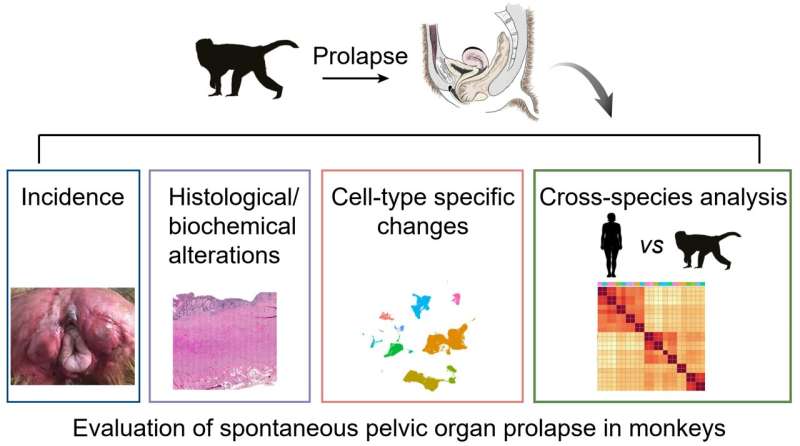This article has been reviewed according to Science X's editorial process and policies. Editors have highlighted the following attributes while ensuring the content's credibility:
fact-checked
trusted source
proofread
A comprehensive evaluation of spontaneous pelvic organ prolapse in non-human primates as a model for human studies

Animal models are urgently needed to evaluate the host tissue responses and safety of newly developed treatments for pelvic organ prolapse (POP). However, there is a lack of suitable animal models for studying POP due to humans' unique pelvic anatomy and physiology.
The current POP models include rats, rabbits, sheep, rhesus macaques, and squirrel monkeys. Several methods have been adopted to mimic the pathological state of POP. However, these animals are quadrupeds and have different anatomy, pelvic floor musculature, and birth processes than humans, so the changes induced by these models do not achieve the comparable structural and functional changes in the pelvic floor that are caused by multiple high-risk factors in humans.
This study was led by Prof. Lan Zhu (Department of Obstetrics and Gynecology, Peking Union Medical College Hospital), Prof. Tao Tan (State Key Laboratory of Primate Biomedical Research, Kunming University of Science and Technology), and Prof. Weizhi Ji (State Key Laboratory of Primate Biomedical Research, Kunming University of Science and Technology).
Notably, spontaneous POP has been reported in nonhuman primates; however, the occurrence of spontaneous POP in elderly rhesus macaques has only been sporadically observed without a comprehensive evaluation or in-depth study. Furthermore, the pathological changes and molecular mechanisms of POP in monkeys and the correlations between human and monkey POP are unknown.
This study examined 72 postmenopausal rhesus macaques (aged 12–28 years) from two regions and evaluated the histopathological changes in the prolapsed vaginal wall in nine monkeys. The incidence of spontaneous POP in monkeys is similar to that of women aged 50-59 years.
Notably, the histological changes in each layer between the POP and control samples were similar in humans and monkeys. α-SMA expression decreased in POP compared with that in the control group, and the POP smooth muscle cells were disorganized and displaced by increased collagen III deposition. The collagen I/III ratio decreased significantly in the lamina propria layer of the prolapsed vaginal wall of the monkeys. Moreover, elastin fiber content decreased significantly in the prolapsed vaginal wall compared with the control vaginal wall.
Next, single-cell RNA sequencing was performed to delineate the molecular regulation of POP in monkeys. The results showed that almost all human and monkey cell types overlapped and were strongly correlated. The terms extracellular matrix (ECM) organization and immune reaction were enriched in differentially expressed genes (DEGs) in almost all nonimmune and immune cell types in human and monkey prolapsed vaginas.
The results revealed ECM dysregulation and immune disorder may be the conserved mechanisms involved in the pathological process of prolapse in both humans and monkeys.
In conclusion, this study included the largest number of experimental animals to date and uncovered the conserved and species-specific molecular pathways underlying the genesis of POP between humans and monkeys. It demonstrated the feasibility and suitability of spontaneous POP in rhesus macaques as an ideal animal model for POP research.
The research is published in the journal Science Bulletin.
More information: Yaqian Li et al, A comprehensive evaluation of spontaneous pelvic organ prolapse in rhesus macaques as an ideal model for the study of human pelvic organ prolapse, Science Bulletin (2023). DOI: 10.1016/j.scib.2023.09.003




















